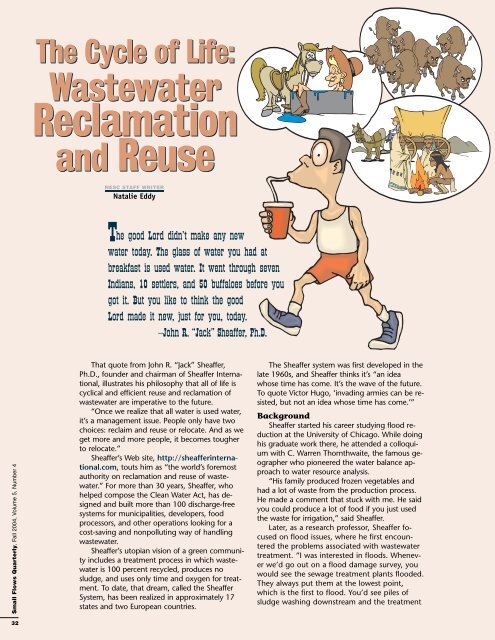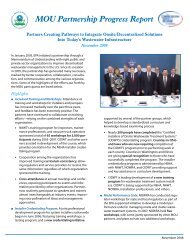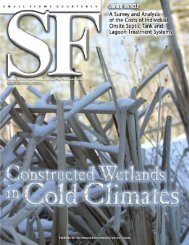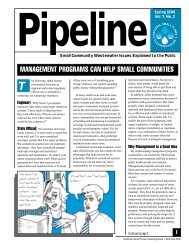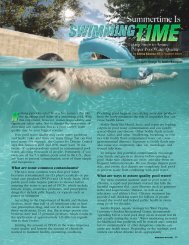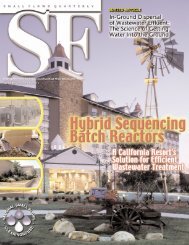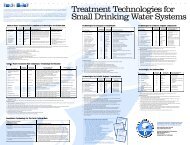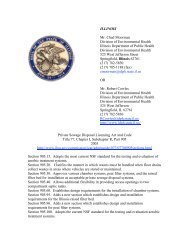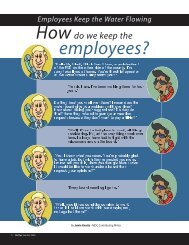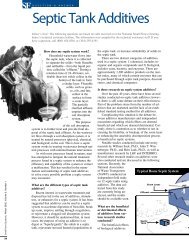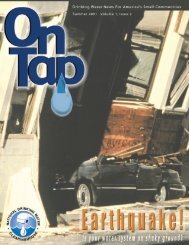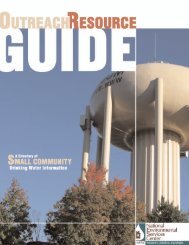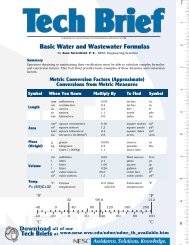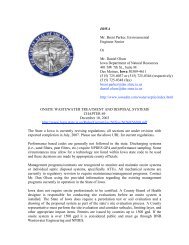Download - National Environmental Services Center - West Virginia ...
Download - National Environmental Services Center - West Virginia ...
Download - National Environmental Services Center - West Virginia ...
Create successful ePaper yourself
Turn your PDF publications into a flip-book with our unique Google optimized e-Paper software.
The Cycle of Life:<br />
Wastewater<br />
Reclamation<br />
and Reuse<br />
NESC STAFF WRITER<br />
Natalie Eddy<br />
The good Lord didn’t make any new<br />
water today. The glass of water you had at<br />
breakfast is used water. It went through seven<br />
Indians, 10 settlers, and 50 buffaloes before you<br />
got it. But you like to think the good<br />
Lord made it new, just for you, today.<br />
—John R. “Jack” Sheaffer, Ph.D.<br />
Small Flows Quarterly, Fall 2004, Volume 5, Number 4<br />
32<br />
That quote from John R. “Jack” Sheaffer,<br />
Ph.D., founder and chairman of Sheaffer International,<br />
illustrates his philosophy that all of life is<br />
cyclical and efficient reuse and reclamation of<br />
wastewater are imperative to the future.<br />
“Once we realize that all water is used water,<br />
it’s a management issue. People only have two<br />
choices: reclaim and reuse or relocate. And as we<br />
get more and more people, it becomes tougher<br />
to relocate.”<br />
Sheaffer’s Web site, http://sheafferinternational.com,<br />
touts him as “the world’s foremost<br />
authority on reclamation and reuse of wastewater.”<br />
For more than 30 years, Sheaffer, who<br />
helped compose the Clean Water Act, has designed<br />
and built more than 100 discharge-free<br />
systems for municipalities, developers, food<br />
processors, and other operations looking for a<br />
cost-saving and nonpolluting way of handling<br />
wastewater.<br />
Sheaffer’s utopian vision of a green community<br />
includes a treatment process in which wastewater<br />
is 100 percent recycled, produces no<br />
sludge, and uses only time and oxygen for treatment.<br />
To date, that dream, called the Sheaffer<br />
System, has been realized in approximately 17<br />
states and two European countries.<br />
The Sheaffer system was first developed in the<br />
late 1960s, and Sheaffer thinks it’s “an idea<br />
whose time has come. It’s the wave of the future.<br />
To quote Victor Hugo, ‘invading armies can be resisted,<br />
but not an idea whose time has come.’”<br />
Background<br />
Sheaffer started his career studying flood reduction<br />
at the University of Chicago. While doing<br />
his graduate work there, he attended a colloquium<br />
with C. Warren Thornthwaite, the famous geographer<br />
who pioneered the water balance approach<br />
to water resource analysis.<br />
“His family produced frozen vegetables and<br />
had a lot of waste from the production process.<br />
He made a comment that stuck with me. He said<br />
you could produce a lot of food if you just used<br />
the waste for irrigation,” said Sheaffer.<br />
Later, as a research professor, Sheaffer focused<br />
on flood issues, where he first encountered<br />
the problems associated with wastewater<br />
treatment. “I was interested in floods. Whenever<br />
we’d go out on a flood damage survey, you<br />
would see the sewage treatment plants flooded.<br />
They always put them at the lowest point,<br />
which is the first to flood. You’d see piles of<br />
sludge washing downstream and the treatment


